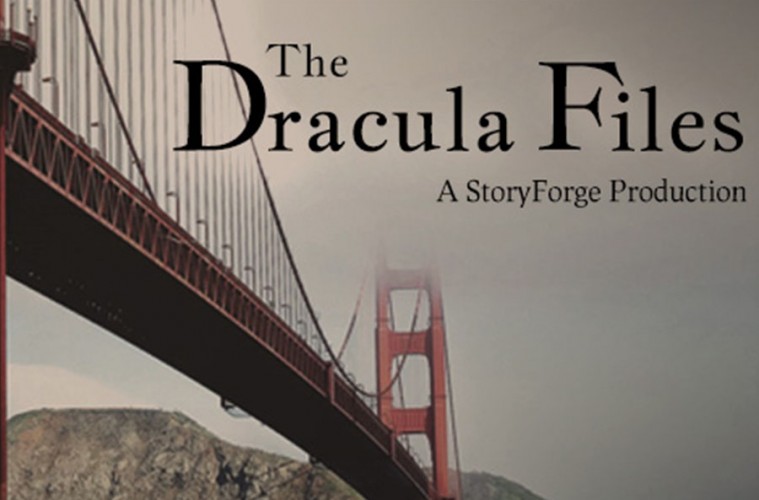Get an inside look at the collaborative strategies and zany adventures of StoryForge Productions, a California-based multimedia production start-up, in this Q&A with founders Karyn Keene and Rachel Beck. Since the first page of their webcomic “House on Writer’s Block” went live in October 2013, the StoryForge team has crawled out of bed for 5 a.m. photoshoots, hurled props out of windows, stolen the show at Wyrd Con, and launched half a dozen projects, all while gathering a vibrant community of artists and storytellers. Read on to find out what they’re up to next.
What gave you the idea for StoryForge Productions?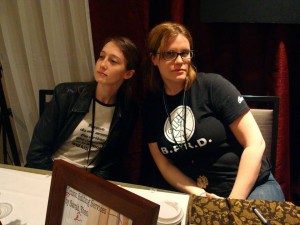
Karyn: One morning when Rachel and I were roommates, I stopped at the kitchen before heading off to work and said, “Why don’t we start a production company?” And then disappeared for six hours. When I came home, Rachel was like, “What do you mean, ‘Start a production company’!?” So we discussed our values and the sorts of stories we wanted to tell.
Rachel: We believe that stories shape the way people see the world.
Karyn: We wanted a multimedia storytelling approach, too. Instead of specializing in one medium, we wanted to smash people from many different disciplines into a room and see what happened. And having both worked at various production companies and seen some of their struggles with managing money and treating people with respect, we wanted to start our own space where we could address those challenges. After about six months of building a team and planning projects, we launched in October 2013.
How do you define “multimedia storytelling”?
Rachel: When you identify any given medium’s inherent strengths and create stories that play to each medium’s advantages. A film, comic, and novel, for example, each lend themselves to a different kind of storytelling; you can use the strengths of each one to tell different parts of the story.
Karyn: Multimedia storytelling can also combine different media into a single project. For example, in “The Myth Archive,” the artwork, narrator, transcript, and musical score all play together. By combining multiple media in one project, we can tell the story in a more engaging way than we could with any single medium on its own.
Rachel: In other words, the whole is greater than the sum of its parts.
How would you describe your cross-disciplinary, collaborative creative process?
Karyn: It’s grounded in adaptability and mutual respect—for the person you’re working with, for the value they bring to the table. For example, Devin Larson, our artist for Yakamoz, has a particular way in which he creates his art, and I have a particular way I like to write. So before we started Yakamoz, we discussed what would be the best way to work together.
Rachel: Everyone has to trust that everyone is fully invested in the project… When anything negative arises that can destroy a project, if you trust each other, you can properly critique the work itself and not the people involved.
Karyn: Trust isn’t just having the project’s best interest in heart, but the person’s. Trusting each other helps you overcome the insecurity everyone feels when collaborating.
What have you learned from collaborating with artists across media and disciplines?
Karyn: That the herding cats metaphor is appropriate!
Rachel: I was surprised by the diversity of approaches found within any medium—that was something we covered in Sarah Yoon’s book, FireStarters. I used think, “You’re an artist; you fit in this slot.” But each artist has his or her own preferences for idea generation and execution.
Karyn: As project manager, I’ve had to figure out how to create a new workflow—to identify a team’s strengths and weaknesses and establish systems that supplement its weak spots, like hitting deadlines or ensuring quality control. To do so, you need to grasp each artist’s workflow better than he or she does and what each genre requires of the artist.
Rachel: That touches on something you need to realize if you want to helm a multimedia project: your job isn’t to do the medium better than anyone else, but to enable your team members who do each medium to do it better than anyone else.
 You’re about to launch your second audio drama series, “The Dracula Files,” in late October. Where did you get the idea for this series?
You’re about to launch your second audio drama series, “The Dracula Files,” in late October. Where did you get the idea for this series?
Karyn: From creating “The Myth Archive,” we knew that audio-led projects are easy and affordable to develop. At Wyrd Con, “Myth Archive” was our surprise bestseller, which prompted us to take a second look at the recent podcast boom. Most podcasts, except for “Welcome to Night Vale,” are nonfiction—journalistic storytelling, not fictional storytelling. While “Myth Archive” filled that gap, we wanted to fill it better.
My husband Kyle threw out the idea for “The Dracula Files” while [we were] sitting in a coffee shop one morning. “If we want to do more audio,” he said, “we could do Dracula—it’s a series of letters, which we could do as found audio files. It would be inexpensive, and it already has a fanbase.” I was like, YES! That would fit that hole in the market perfectly! So I had him pitch the idea to Rachel, who loved it!
Rachel: Then we locked ourselves in a cabin for several long weekends and wouldn’t let ourselves out until we had an outline and a completed draft. The story was literally strung all over the walls on notecards, like a mad scientist’s house!
How has the creative process for “Dracula” differed from that of “Myth Archive”?
Karyn: “Dracula” is a massive project. “Myth Archive” is just four people, but “Dracula” has twelve actors and a full crew.
Rachel: Basically, it’s a film set sans camera.
Karyn: I’m trained as a casting director, so we did a whole movie-style casting session, but hired some fantastic people who want to break into voice acting. Working with them has been a lot of fun!
You’ve mentioned another project you’ve got in development: Yakamoz: Cosmo’s Mirror. What excites you about this comic?
Karyn: Yakamoz is the story of a young man living in Istanbul, an ancient city where East and West collide. When I was a kid, my grandparents lived in Turkey and we travelled there a lot. I love it. So I took the story the protagonist reads in the fairy library in George MacDonald’s Phantastes and retold it in turn-of-the-twentieth-century Istanbul (then still Constantinople) to Westerners. There are lots of mystical elements: Cosmo is an alchemist, and the story itself is structured according to alchemical storytelling, like Dante’s Divine Comedy. Yakamoz is also our first foray into print comics. Devin’s a fabulous artist, so whenever I get to see a new page, I get so excited!
Rachel: And though we’ve just got one page on our website about the project, our community’s already really excited!
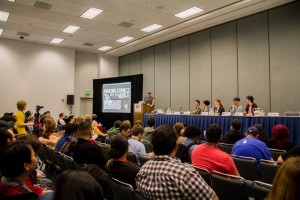 How would you describe your online storytelling community?
How would you describe your online storytelling community?
Rachel: Fun! Stories are a way that we make sense of the world, so connecting
people from all over the world via the Internet to tell stories brings the world closer together.
Karyn: We’ve attracted a group of people who believe in our mission, who want to tell their own stories well and encourage others to be fantastic. I love jumping on our Twitter feed and talking to our fans!
How have you seen your online community feed on and into real-world events like cons?
Rachel: We had a cosplay scavenger hunt! People tweeted us characters to find and photograph ourselves with. Once we did, we’d post the pics and get new submissions.
Karyn: Then people on the floor joined in, and it became a Twitter handle. They were like, “We found that guy!” And we were like, “Hey, that’s awesome!” Next time, we’re going to print business cards that say “StoryForge Scavenger Hunt,” with a quick overview of how it works. It’s also great in that it allows people who can’t be there to feel involved in the convention.
What other crazy things have happened, at a con or on set?
Karyn: For “Dracula,” we had to create the sound of a man escaping from a castle. One of the guys on set has this suit he uses as a plumber, which we stuffed with books to turn it into a life-sized dummy. Then we put an iPod in its pocket, dragged it to the second floor of this old creepy church building we used as a castle, and hurled it out the window!
Rachel: And right into the bushes!
Karyn: We got this big, crashing sound. Also, one of our actors also went to town on a watermelon wrapped with rags when he was trying to murder Dracula.
If you could be one of the characters you’ve created (or adapted) for StoryForge, who would it be and why?
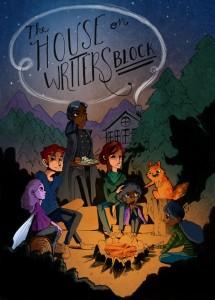 Karyn: Lyra, from our first webcomic, “House on Writer’s Block.” She’s an adorable six-year-old seer who can see the future but not the present, so she’s constantly confusing her timelines.
Karyn: Lyra, from our first webcomic, “House on Writer’s Block.” She’s an adorable six-year-old seer who can see the future but not the present, so she’s constantly confusing her timelines.
Rachel: Van Helsing in “Dracula,” because he’s a good man who risks everything to save the day. Especially the Van Helsing that we crafted: he’s this courteous, funny old guy who kills vampires and zombies! I want to be like that when I grow up.
If someone has never listened to an online audio drama or read a webcomic, where (besides your work) would you recommend they start?
Karyn: For audio fiction, I would send them to “Welcome to Night Vale.”
Rachel: For comics, I’d say “Girl Genius” or “The Glass Scientists.”
Get connected with StoryForge Productions (@Storyforgers), Karyn (@Karyn_Keene), and Rachel (@rachelthebeck) on Twitter and follow StoryForge on Facebook.
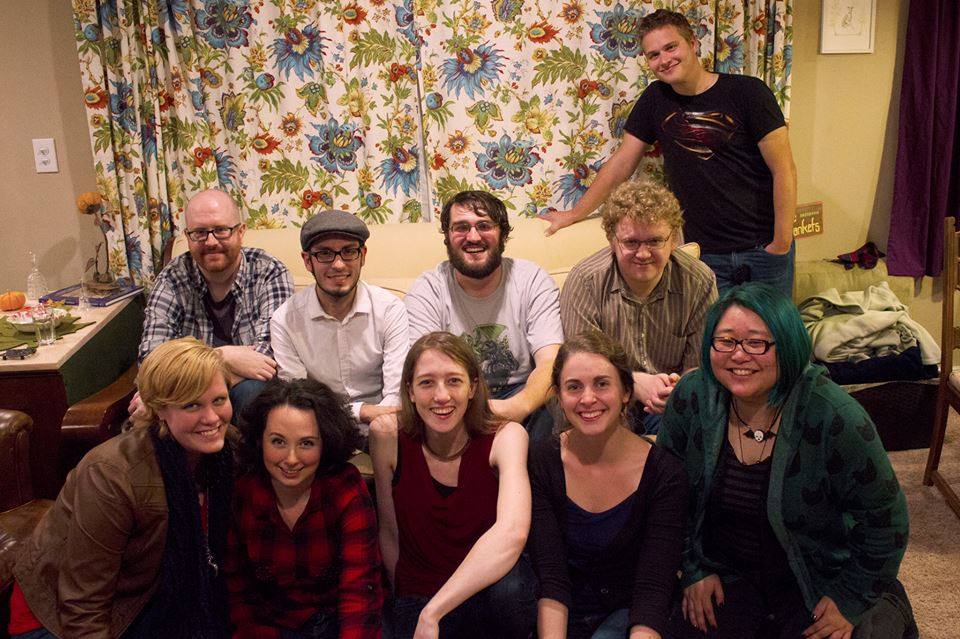
Elaine K. Phillips wrote a big fat thesis on transmedia storytelling for her MA in Publishing at Oxford Brookes University, but she prefers to pen magazine features and adventure tales. She finished her first (bad, bad, bad) science-fiction novel at eleven and is currently writing an alternate history sci-fi novel that weaves together the fifteenth-century Plantagenet, Ashikaga, and Zhu dynasties. She’d love to chat with you about new media, history, or tech via Twitter (@elainekphillips) or her website.
All images provided by StoryForge Productions


